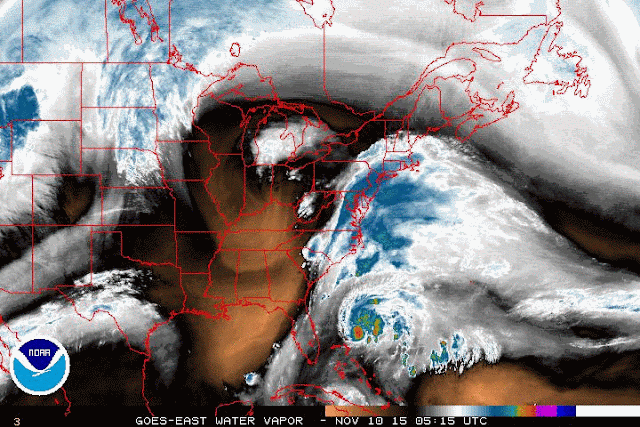 |
| Bay/East entrance, July 2011. (photo by Brian McNoldy) |
Villa Vizcaya was built in 1914-1922 by James Deering. James was the son of William Deering, of Deering Harvester Company fame in the late 1800s. James joined the company when he was 21, and when he was 43, J.P. Morgan facilitated a merger with McCormick Reaper Company to form International Harvester, which quickly became the largest agricultural equipment manufacturer in the country.
James lived in Chicago, and wanted a winter house in south Florida. The pristine tropical coastline of Biscayne Bay near Miami was his chosen location (
area map) for an immense 180-acre estate featuring manicured gardens, statues, and a mansion built in the Mediterranean Revival style.
 |
| Aerial view of the mansion, gardens, and stone barge in the bay entrance. (Google Earth) |
James died in 1925 at age 66, and just one year later, the Great Miami Hurricane of 1926 severely damaged the property. Efforts to restore it were set back again by the Labor Day Hurricane of 1935. In the 1950s, James' heirs gifted the estate to Dade County, and it finally re-opened as
Vizcaya Museum & Gardens for the public to experience and enjoy. In 1979, it was added to the National Register of Historic Places, and remains a beautiful public museum today (
Vizcaya Museum & Gardens website) despite subsequent destructive hurricanes such as Andrew in 1992 and Wilma in 2005.
One thing James couldn't have anticipated 100 years ago was that the spectacular bay-front location would be endangered by the bay itself. Archeological work being conducted in downtown Miami by Robert Carr and colleagues recently "provided proof that sea level in the area had risen more than a foot in the last century" (
Miami Herald article), and my own work with tide gauge data from nearby Virginia Key suggests that the sea level has risen nearly 4 inches in just the past 20 years, and that the rate of sea level rise is accelerating (
RSMAS blog post).
So, I wanted to compare some photographs of the estate taken nearly 100 years ago to some taken during a "king tide" on October 28, 2015 from nearly the same vantage points. With assistance from Remko Jansonius, Nydia Perez, and Emily Gibson at Vizcaya's Collections and Curatorial Division, the following comparisons offer some perspective on the rising seas that will threaten this unique and historic gem in the coming years and decades.
 |
| Front of the decorative stone barge in 1916 (top) and October 2015 (bottom). Top photo is courtesy of the Arva Moore Parks Vizcaya Photograph Collection, Vizcaya Museum & Gardens. Bottom photo by Brian McNoldy. |
|
|
|
 |
| Side of decorative stone barge showing steps and statues of Hermes in 1917 (top) and October 2015 (bottom). Top photo courtesy of the Construction Photograph Albums, Vizcaya Museum & Gardens. Bottom photo by Brian McNoldy. |
|
Read more here: http://www.miamiherald.com/news/local/community/miami-dade/article11113340.html#storylink=cpy
 |
| Looking toward the north boat landing from the east entrance in January 1917 (top) and October 2015 (bottom). Top photo courtesy of the Construction Photograph Albums, Vizcaya Museum & Gardens. Bottom photo by Brian McNoldy. |
 |
| Bridge to the north landing in 1917 (top, with gondolas) and October 2015 (bottom). Top photo courtesy of the Arva Moore Parks Vizcaya Photograph Collection, Vizcaya Museum & Gardens. Bottom photo by Brian McNoldy. |
 |
| Bayfront view of Vizcaya from the north landing in 1917 (top) and
October 2015 (bottom). Top photo courtesy of the Construction
Photograph Albums, Vizcaya Museum & Gardens. Bottom photo by Brian
McNoldy. | |
|
|
|
|
|
|
|
|
|
|
|
|
|
|
|
|
| |
For the next two photo comparisons, we fast-forward by 30-35 years to the early 1950s.
 |
| Bayfront view of Vizcaya from the north landing in 1950 (top) and October 2015 (bottom). Top photo detail courtesy of the Richard B. Hoit Photograph Collection, Vizcaya Museum & Gardens. Bottom photo by Brian McNoldy. |
 |
| Looking toward the decorative stone barge from the bayfront entrance in 1952 (top) and October 2015 (bottom). Top photo detail courtesy of the Rudi Rada Photograph Collection, Vizcaya Museum & Gardens. Bottom photo by Brian McNoldy. |
Although the photos from 2015 were taken during a very high "king tide",
that water level will soon enough be the new average, and then
eventually the new low tide. Sea level rise
is happening, and will
continue to happen at even greater rates than we've ever measured. The
last 4 inches of sea level rise took 20 years to occur, but the next 4
inches may only take another 10 years or less!
Some additional photos from the October 28, 2015 "king tide" are provided here without comparison, but set a benchmark for the next generation of Vizcaya photographers...
 |
| Gazebo on the south side of the bayfront entrance. Photo by Brian McNoldy. |
 |
| Only a few steps still remain above water on the bayfront entrance. Photo by Brian McNoldy. |
 |
| Close-up of the stone barge, which appears to be two separate features. Photo by Brian McNoldy. |
 |
| An area of the secluded south landing. Photo by Brian McNoldy. |


















































